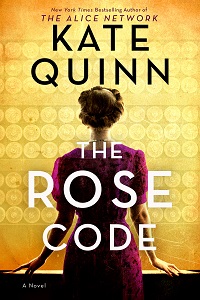From watching The Bletchley Circle, I knew what had taken place during WWII at Bletchley, the center of codebreaking activities, and the heroic acts of the thousands of very smart people employed there during the war, most of them women. Their work was key to the Allied victory and reportedly shortened the length of the war by two years.
 |
| Bletchley Park mansion from a distance, and small lake, which appears in the story early on. Photo taken by me (7-15-19) |
So of course when I first heard about Kate Quinn's The Rose Code, I knew I'd have to read it. When I had a break between review assignments this past week, I dived right in.
The Rose Code is a smart, character-driven historical thriller about three women who become unlikely friends and allies while working at Bletchley during the war, and the terrible betrayals that destroyed their strong bond.
 |
| Work tables inside one of the huts |
Mab Churt is a tall, self-sufficient East Ender worried about her mother and younger sister in London. Canadian-born Osla Kendall, a character based on Osla Benning, an early girlfriend of Prince Philip, runs in elite social circles and has led a relatively sheltered life. She has a talent for languages and wants the world to know she's more than a "silly deb." Lastly, shy Beth Finch, a whiz with puzzles, escapes her overbearing mother's insults and abuse when she discovers, to her astonishment, that she fits in with the other codebreakers at Bletchley. Their work is so secret that each worker only knows their own task.
Alternating chapters set in 1947, in the days leading up to the royal wedding, follow the trio as they're forced to reunite, with one of them held against her will in a sanitarium, in order to unmask a spy within their earlier ranks.
Alternating chapters set in 1947, in the days leading up to the royal wedding, follow the trio as they're forced to reunite, with one of them held against her will in a sanitarium, in order to unmask a spy within their earlier ranks.
 |
| Exhibit on operating the Bombes |
The story takes you right inside the huts at Bletchley where all the codebreaking takes place and also inside the characters' heads as they try to crack the codes used by the Germans. You feel their exhaustion as they push themselves to their physical and mental limits, and rejoice when they succeed in finding the right pattern. Mab becomes one of the women operating the decryption machine known as the Bombe (image above). When I visited in summer, the huts were cool, but all of the rooms are fairly small, with narrow corridors connecting them. One could easily imagine how hot and cramped they were, with the women constantly in motion as they put the heavy drums in their slots and adjusted the wires to keep the Bombe running.
The setup at Bletchley, in July 2019, made it appear as if the huts' occupants had just stepped away from their desks for lunch.
The story makes for compulsive reading as it interweaves the women's friendships with several poignant love stories and the intense race-against-time atmosphere of the earlier and later timelines.
 |
| The office inside the Bletchley Park mansion |
It does feel rather startling to have just finished this novel as Prince Philip's death was announced, as he's a major character. In The Rose Code he's the dashing and tanned Prince Philip of Greece, Royal Navy officer and distant relative of the British royals. He and his girlfriend, Osla, set up by a mutual friend, share the feeling of having no real home. His depiction feels realistic and respectful.
I'd love to see the novel as a film, and with the recent announcement of a TV adaptation, hopefully that will happen in the near future. Both a visit to Bletchley and the novel itself are definitely recommended. (Thanks to the publisher, William Morrow, for approving an e-copy via Edelweiss.)








Just looking at those chairs makes my back and neck and arms and wrists scream. We didn't know about ergonomics back then, plus, Depression and then WAR. So many ways these women are heroic.
ReplyDeleteI would not deal well with those chairs either. Very little there was designed for comfort.
ReplyDeleteGreat article - loved the pictures - it was how I pictured it while reading the book.
ReplyDeleteThanks! The author did a great job of describing the layout and atmosphere. It was like being right back there.
ReplyDeleteThank you for this great review and the great photos of Bletchley. I can't wait to read this book.
ReplyDeleteThanks, Alex! Hope you'll love the book also.
ReplyDeleteThanks for sharing these great pictures
ReplyDelete